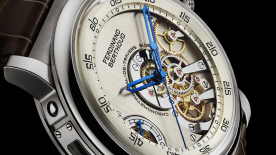Last May, Richemont officially unveiled the Campus Genevois de Haute Horlogerie in Meyrin, a “town within a town” that is home to nine organisations including five watchmaking companies, as well as the Ecole des Métiers et Artisans de Haute Horlogerie, on its 45,000 m2 grounds. The cornerstone of this incubator is the Ecole des Métiers et Artisans de Haute Horlogerie, whose ambition is to “organise a variety of training courses, to perpetuate certain skills and create new courses, to coordinate the curricula of several schools around the world, to pass on and certify knowledge and, of course, to encourage more people to enter the watchmaking professions.”
Today, we shall look at basic courses that lead to a certificate. The pillars of the Ecole des Métiers et Artisans de Haute Horlogerie are the foundation courses (AFP – Attestation fédérale de formation professionelle and CFC – Certificat fédéral de capacité), whose aim is to perpetuate the Haute Horlogerie trades. There are four courses leading to certification as micromechanic, watchmaking operator, production watchmaker and engraver. The first course for enamellers is scheduled to open in August 2017. The length of the courses is between two and four years, and they are aimed at young school leavers. Apprentices will benefit from a high level of individual attention from the seven full-time instructors, as well as a stimulating professional environment. As part of the course, the students have six months’ work experience in the heart of the watchmaking industry with one of the partner companies in the Richemont group, which sponsors the students. Another strength of the programme is that it offers training in artistic crafts such as engraving, which has been unavailable in Geneva for the last fifteen years, and enamelling, for which no training courses currently exist. The school also places great emphasis on not separating the more technical skills from the crafts. The apprentices are involved with each other on a day-to-day basis, and learn about how the different skills interact, as well as their limitations.
The Ecole des Métiers et Artisans de Haute Horlogerie is active internationally, with offshoots in Dallas, Hong Kong and Shanghai regulated by the Institute of Swiss Watchmaking (IOSW). It is open to all watchmaking concerns wishing to take advantage of the resources put in place by Richemont.
Next week we’ll take a look at another kind of programme, for watch industry professionals.




